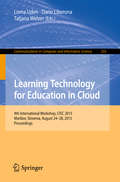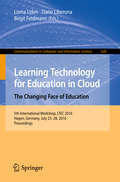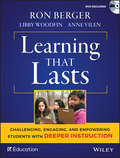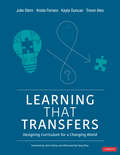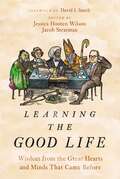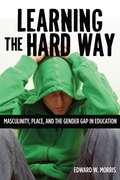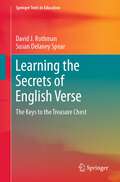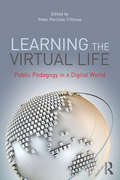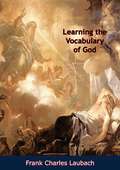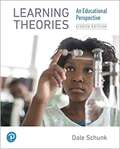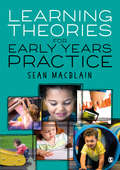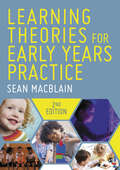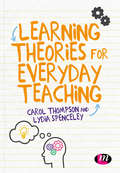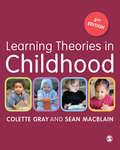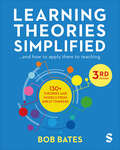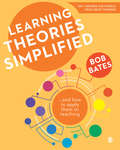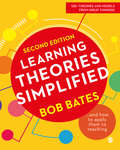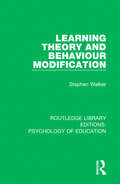- Table View
- List View
Learning Technology for Education in Cloud
by Lorna Uden Dario Liberona Tatjana WelzerThis book constitutes the refereed proceedings of the Fourth International Workshop on Learning Technology for Education in Cloud, LTEC 2015, held in Maribor, Slovenia, in August 2015. The 24 revised full papers presented were carefully reviewed and selected from 46 submissions. The papers cover various aspects of technologies for learning, such as MOOC challenges; cooperative learning; learning engineering; learning tools and environments; STEM.
Learning Technology for Education in Cloud - The Changing Face of Education
by Lorna Uden Dario Liberona Birgit FeldmannThis book constitutes the refereed proceedings of the 5th International Workshop on Learning Technology for Education in Cloud, LTEC 2016, held in Maribor, Slovenia, in July 2016. The 25 revised full papers presented were carefully reviewed and selected from 51 submissions. The papers are organized in topical sections on learning technologies; learning tools and environment; MOOC for learning; problem solving and knowledge transfer; case study.
Learning That Lasts: Challenging, Engaging, and Empowering Students with Deeper Instruction
by Jal Mehta Ron Berger Libby Woodfin Anne VilenA practical guide to deeper instruction--a framework for challenging, engaging, and empowering students of all ages For schools to meet ambitious new standards and prepare all students for college, careers, and life, research has shown unequivocally that nothing is more important that the quality of daily instruction. Learning That Lasts presents a new vision for classroom instruction that sharpens and deepens the quality of lessons in all subject areas. It is the opposite of a 'teacher-proof' solution. Instead, it is predicated on a model of instruction that honors teachers as creative and expert planners of learning experiences for their students and who wish to continuously grow in their instructional and content knowledge. It is not a theoretical vision. It is a model of instruction refined in some of the nation's most successful public schools--schools that are beating the odds to create remarkable achievement--sited primarily in urban and rural low-income communities. Using case studies and examples of powerful learning at all grade levels and in all disciplines, Learning That Lasts is a guide to creating classrooms that promote deeper understanding, higher order thinking, and student independence. Through text and companion videos, readers will enter inspiring classrooms where students go beyond basics to become innovators, collaborators, and creators. Learning That Lasts embraces a three-dimensional view of student achievement that includes mastery of knowledge and skills, character, and high-quality work. It is a guide for teachers who wish to make learning more meaningful, memorable, and connected to life, and inspire students to do more than they think possible.
Learning That Transfers: Designing Curriculum for a Changing World (Corwin Teaching Essentials)
by Julie Stern Krista Ferraro Kayla Duncan Trevor Aleo"It is a pleasure to have a full length treatise on this most important topic, and may this focus on transfer become much more debated, taught, and valued in our schools." - John Hattie Teach students to use their learning to unlock new situations. How do you prepare your students for a future that you can’t see? And how do you do it without exhausting yourself? Teachers need a framework that allows them to keep pace with our rapidly changing world without having to overhaul everything they do. Learning That Transfers empowers teachers and curriculum designers alike to harness the critical concepts of traditional disciplines while building students’ capacity to navigate, interpret, and transfer their learning to solve novel and complex modern problems. Using a backwards design approach, this hands-on guide walks teachers step-by-step through the process of identifying curricular goals, establishing assessment targets, and planning curriculum and instruction that facilitates the transfer of learning to new and challenging situations. Key features include Thinking prompts to spur reflection and inform curricular planning and design. Next-day strategies that offer tips for practical, immediate action in the classroom. Design steps that outline critical moments in creating curriculum for learning that transfers. Links to case studies, discipline-specific examples, and podcast interviews with educators. A companion website that hosts templates, planning guides, and flexible options for adapting current curriculum documents. Using a framework that combines standards and the best available research on how we learn, design curriculum and instruction that prepares your students to meet the challenges of an uncertain future, while addressing the unique needs of your school community.
Learning That Transfers: Designing Curriculum for a Changing World (Corwin Teaching Essentials)
by Julie Stern Krista Ferraro Kayla Duncan Trevor Aleo"It is a pleasure to have a full length treatise on this most important topic, and may this focus on transfer become much more debated, taught, and valued in our schools." - John Hattie Teach students to use their learning to unlock new situations. How do you prepare your students for a future that you can’t see? And how do you do it without exhausting yourself? Teachers need a framework that allows them to keep pace with our rapidly changing world without having to overhaul everything they do. Learning That Transfers empowers teachers and curriculum designers alike to harness the critical concepts of traditional disciplines while building students’ capacity to navigate, interpret, and transfer their learning to solve novel and complex modern problems. Using a backwards design approach, this hands-on guide walks teachers step-by-step through the process of identifying curricular goals, establishing assessment targets, and planning curriculum and instruction that facilitates the transfer of learning to new and challenging situations. Key features include Thinking prompts to spur reflection and inform curricular planning and design. Next-day strategies that offer tips for practical, immediate action in the classroom. Design steps that outline critical moments in creating curriculum for learning that transfers. Links to case studies, discipline-specific examples, and podcast interviews with educators. A companion website that hosts templates, planning guides, and flexible options for adapting current curriculum documents. Using a framework that combines standards and the best available research on how we learn, design curriculum and instruction that prepares your students to meet the challenges of an uncertain future, while addressing the unique needs of your school community.
Learning the Good Life: Wisdom from the Great Hearts and Minds That Came Before
by Jessica Hooten Wilson Jacob StratmanDiscover the Good Life as You Learn from the Wise Voices of the PastWe've lost ourselves. Disconnected from the past and uncertain about the future, we are anxious about what our lives will be and troubled by a nagging sense of meaninglessness. Adrift in the world, many Christians have their identity completely wrapped up in work and their definition of the "good life" is financial success. Fewer of are staying committed to the Christian faith, finding it difficult to reconcile their experience with their longings and desires. With so much uncertainty, where can we find a true vision of "the Good Life"?Learning the Good Life speaks to this malaise with trusted and assured voices from the past, inviting Christians into an age-old conversation with some of history's wisest hearts and minds as their dialogue companions. Featuring classic writings from a diverse lineup of over 35 writers and thinkers including Confucius, Augustine, Sor Juana Inés de la Cruz, W.E.B. DuBois, Flannery O'Connor, and Wendell Berry. Together these sages of the past address important issues such as:VocationCallingMeaningSufferingBeautyVirtueLearningWisdomCritical ThinkingCommunityWonderReflectionAnd moreEach of these texts are introduced by experts who are teachers, from a variety of Christian colleges and universities, to help providing a broader, richer, and more cohesive narrative in which Christians may participate. In addition to a substantive introduction, each text is accompanied by discussion questions to provoke further thought and contemplation and also to facilitate discussion when used in groups. Ideal for any Christian seeking a deeper connection to the wisdom of the past and wanting a more cohesive and beautiful vision of the good life. All the writers have a message for you. All of them are calling you to die to yourself, to your habits of indulgence, to your pride and ambition, and instead, dedicate your time to learning, thinking, and loving.Writers and writings featured in Learning the Good Life include:Lao Tzu, From Tao Te ChingConfucius, SelectionsPlato, The Allegory of the CaveSeneca the Younger, "On the Shortness of Life"Athanasius, On the IncarnationGregory of Nazianzus, On My Own VersesAugustine, On the TeacherAugustine, On Christian Doctrine, Book I.Pope Gregory the Great, Life of Saint Benedict, Dialogues, Book 2Dante Alighieri, The Divine Comedy, Inferno 1Nezahualcoyotl, "A Flower Song of Nezahualcoyotl"Margery Kempe, From "The Book of Margery Kempe"William Shakespeare, King LearJohn Amos Comenius, From The Labyrinth of the World and the Paradise of the HeartGeorge Herbert, Five PoemsBlaise Pascal, SelectionsMatsuo Basho, Three Haiku PoemsSor Juana Ines de la Cruz, "Respuesta a Sor Filotea de la Cruz"John Milton, AreopagiticaJonathan Edwards, "Personal Narrative"Edmund Burke, Reflections on the Revolution in FranceLord Alfred Tennyson, "Ulysses"Frederick Douglass, Narrative LifeElizabeth Barrett Browning, from Aurora LeighHenry David Thoreau, "Life Without Principle"Gerard Manley Hopkins, "As Kingfishers Catch
Learning the Hard Way: Masculinity, Place, and the Gender Gap in Education
by Edward W. MorrisAn avalanche of recent newspapers, weekly newsmagazines, scholarly journals, and academic books has helped to spark a heated debate by publishing warnings of a "boy crisis" in which male students at all academic levels have begun falling behind their female peers. In Learning the Hard Way, Edward W. Morris explores and analyzes detailed ethnographic data on this purported gender gap between boys and girls in educational achievement at two low-income high schools--one rural and predominantly white, the other urban and mostly African American. Crucial questions arose from his study of gender at these two schools. Why did boys tend to show less interest in and more defiance toward school? Why did girls significantly outperform boys at both schools? Why did people at the schools still describe boys as especially "smart"? Morris examines these questions and, in the process, illuminates connections of gender to race, class, and place. This book is not simply about the educational troubles of boys, but the troubled and complex experience of gender in school. It reveals how particular race, class, and geographical experiences shape masculinity and femininity in ways that affect academic performance. His findings add a new perspective to the "gender gap" in achievement.
Learning the Secrets of English Verse: The Keys to the Treasure Chest (Springer Texts in Education)
by David J. Rothman Susan Delaney SpearThis textbook teaches the writing of poetry by examining all the major verse forms and repeating stanza forms in English. It provides students with the tools to compose successful lines of poetry and focuses on meter (including free verse), rhythm, rhyme, and the many other tools a poet needs to create both music and meaningfulness in an artful poem. Presenting copious examples from strong poets of the past and present along with many recent student examples, all of which are scanned, each chapter offers lessons in poetic history and the practice of writing verse, along with giving students a structured opportunity to experiment writing in all the forms discussed. In Part 1, Rothman and Spear begin at the beginning, with Anglo-Saxon Strong Stress Alliterative Meter and examine every major meter in English, up to and including the free verse forms of modern and contemporary poetry. Part 2 presents a close examination of stanza forms that moves from the simple to the complex, beginning with couplets and ending with the 14-line Eugene Onegin stanza. The goal of the book is to give students the essential skills to understand how any line of poetry in English may have been composed, the better to enjoy them and then also write their own: the keys to the treasure chest. Rothman and Spear present a rigorous curriculum that teaches the craft of poetry through a systematic examination and practice of the major English meters and verse forms. Under their guidance, students hone their craft while studying the rich traditions and innovations of poets writing in English. Suitable for high school students and beyond. I studied with Rothman in graduate school and went through this course with additional scholarly material. This book will help students develop a keen ear for the music of the English language.—Teow Lim Goh, author of Islanders
Learning the Virtual Life: Public Pedagogy in a Digital World
by Peter Pericles TrifonasDigital technologies have transformed cultural perceptions of learning and what it means to be literate, expanding the importance of experience alongside interpretation and reflection. Learning the Virtual Life offers ways to consider the local and global effects of digital media on educational environments, as well as the cultural transformations of how we now define learning and literacy. While some have welcomed the educational challenges of digital culture and emphasized its possibilities for individual emancipation and social transformation in the new information age, others accuse digital culture of absorbing its recipients in an all-pervasive virtual world. Unlike most accounts of the educational and cultural consequences of digital culture, Learning the Virtual Life presents a neutral, advanced introduction to the key issues involved with the integration of digital culture and education. This edited collection presents international perspectives on a wide range of issues, and each chapter combines upper-level theory with "real-world" practice, making this essential reading for all those interested in digital media and education.
Learning the Vocabulary of God: A Spiritual Diary
by Frank Charles LaubachFrank Charles Laubach was an Evangelical Christian missionary and mystic known as "The Apostle to the Illiterates." It was a daily record of an effort to hear God's instructions, minute by minute, and to carry them out in a new, creative field which was far beyond anything the author had undertaken.-Print ed.
Learning Theories: An Educational Perspective
by Dale SchunkA comprehensive look at the key theoretical principles, concepts, and research findings about learning, with special attention paid to how these concepts and principles can be applied in today’s classrooms. <p><p> This widely used and respected resource introduces readers to the key theoretical principles, concepts, and research findings about learning and helps them see how to apply that theory and research as educators. Learning Theories begins with a discussion of the relationship between learning theory and instruction. It then looks at the neuroscience of learning. Six chapters cover the major theories of learning ― behaviorism, social cognitive theory, information processing theory, cognitive learning processes, and constructivism. The following three chapters cover key topics related to learning ― motivation, self-regulated learning, and contextual influences. And the final chapter, Next Steps, helps students consolidate their views about learning. The 8th Edition has been significantly updated with a number of new features and the most current thinking and research.
Learning Theories for Early Years Practice
by Sean MacBlainUnderstanding and applying learning theories is crucial to the transition from study or training, to practice in a real-world setting. This new textbook will prepare the reader by demonstrating how key learning theories pan out in practice, with the aid of photographs, examples and clear explanations. Divided into three main sections, Early Influences, Modern Influences, and Challenges for Theorists in a Changing World, this author identifies the key theorists in early childhood, past and present, before linking them to the main issues and developments that face early years practitioners today. An explanation of each key theorist is guided by a clear structure, including: links to other theorists strengths and weaknesses of the theory the theory in practice Packed full of case studies, activities, points for discussion, extended and recommended reading, this is a fantastic resource for students and teachers who want to build a strong foundation in learning theories, to enable them to support the young children in their care as effectively as possible.
Learning Theories for Early Years Practice
by Sean MacBlainUnderstanding and applying learning theories is crucial to the transition from study or training, to practice in a real-world setting. This new textbook will prepare the reader by demonstrating how key learning theories pan out in practice, with the aid of photographs, examples and clear explanations. Divided into three main sections, Early Influences, Modern Influences, and Challenges for Theorists in a Changing World, this author identifies the key theorists in early childhood, past and present, before linking them to the main issues and developments that face early years practitioners today. An explanation of each key theorist is guided by a clear structure, including: links to other theorists strengths and weaknesses of the theory the theory in practice Packed full of case studies, activities, points for discussion, extended and recommended reading, this is a fantastic resource for students and teachers who want to build a strong foundation in learning theories, to enable them to support the young children in their care as effectively as possible.
Learning Theories for Early Years Practice
by Sean MacBlainThe perfect guide for students who need to get to grips with learning theories and how they relate to the early years, this book covers Early and Modern theorists and their theories, and how they apply today. Bursting with full colour photographs, case studies, activities and discussion points, each chapter explores the theorist and the theory; what the theory looks like in practice; the strengths and weaknesses of each theory; and its links to other theorists. This new edition includes: Three new chapters on Bowlby, Dweck and Claxton New reflective activities New critical questions following the case studies
Learning Theories for Early Years Practice
by Sean MacBlainThe perfect guide for students who need to get to grips with learning theories and how they relate to the early years, this book covers Early and Modern theorists and their theories, and how they apply today. Bursting with full colour photographs, case studies, activities and discussion points, each chapter explores the theorist and the theory; what the theory looks like in practice; the strengths and weaknesses of each theory; and its links to other theorists. This new edition includes: Three new chapters on Bowlby, Dweck and Claxton New reflective activities New critical questions following the case studies
Learning Theories for Everyday Teaching
by Carol Thompson Lydia SpenceleyAn essential tool for new teachers and trainees who want to use learning theories to develop their practice. The text explores key learning theories in a pragmatic way and encourages focused reflection to promote critical analysis of theories and their potential application to specific contexts. The authors highlight the practical benefits of using theory in planning, teaching and reflecting on practice. The text also encourages the use of a range of creative approaches to enhance learning. Each chapter explores a key aspect of the teacher's role (such as planning, motivation or assessment) and outlines theories relating to this theme - fully embedding the use of learning theories in practical every day teaching. It includes activities for reflection and a section encouraging readers to 'map' the theory to their own practice. Scenarios and case studies throughout illustrate learning and support readers link theory to practice.
Learning Theories for Everyday Teaching
by Carol Thompson Lydia SpenceleyAn essential tool for new teachers and trainees who want to use learning theories to develop their practice. The text explores key learning theories in a pragmatic way and encourages focused reflection to promote critical analysis of theories and their potential application to specific contexts. The authors highlight the practical benefits of using theory in planning, teaching and reflecting on practice. The text also encourages the use of a range of creative approaches to enhance learning. Each chapter explores a key aspect of the teacher's role (such as planning, motivation or assessment) and outlines theories relating to this theme - fully embedding the use of learning theories in practical every day teaching. It includes activities for reflection and a section encouraging readers to 'map' the theory to their own practice. Scenarios and case studies throughout illustrate learning and support readers link theory to practice.
Learning Theories in Childhood
by Sean Macblain Colette GrayBy focusing on the early philosophies of learning and the key behavioural, cognitive and social theorists, this book provides a comprehensive overview of children's learning. The authors discuss the key learning theories, highlight the strengths and weaknesses of each approach and encourage reflection on how different approaches impact on the learning environment. The discussion finishes with an exploration of the new sociology of childhood. Examples are drawn from practice to highlight key concepts, and to make vital links between theory and practice.<P><P> Theorists considered include:<P> - Locke<P> - Rousseau<P> - Montesori<P> - Piaget<P> - Vygotsky<P> - Bandura<P> - Bronfenbrenner <P> - Bruner<P> Accessibly written, with key questions and recommended reading included, this book is essential reading for all those studying on child development, early childhood and childhood studies courses, and for anyone interested in understanding more about how children learn and think.<P> Colette Gray is Principal Lecturer in Early Childhood Education at Stranmillis University.<P> Dr Sean MacBlain is Reader in Child Development and Disability at University College Plymouth, St. Mark & St. John.
Learning Theories Simplified: ...and how to apply them to teaching
by Bob BatesAre you struggling to get your head around John Dewey’s educational pragmatism? What exactly is Jean Piaget saying about cognitive development? Maybe you’re running out of time and patience making sense of Rosenshine′s Principles of Instruction? Have you reached breaking point reading Daniel T. Willingham on educational neuroscience? Written for busy teachers, students, trainers, managers and , this ′dip-in, dip-out′ guide makes theories of learning accessible and practical. It explores 134 classic and contemporary learning theorists in an easy-to-use, bite-sized format with clear relevant illustrations on how each theory will benefit teaching and learning. Each model or theory is explained in less than 350 words, followed by a ′how to use it′ section. New to this third edition: New section on cognitive learning theory, including Arthur Shimamura, Alison Gopnik, John Flavell and more Enhanced critical perspectives offering a deeper examination of each theory′s strengths and weaknesses A new entry on Gloria Ladson-Billings and Critical Race Theory in education
Learning Theories Simplified: ...and how to apply them to teaching
by Bob BatesAre you struggling to get your head around John Dewey’s educational pragmatism? What exactly is Jean Piaget saying about cognitive development? Maybe you’re running out of time and patience making sense of Rosenshine′s Principles of Instruction? Have you reached breaking point reading Daniel T. Willingham on educational neuroscience? Written for busy teachers, students, trainers, managers and , this ′dip-in, dip-out′ guide makes theories of learning accessible and practical. It explores 134 classic and contemporary learning theorists in an easy-to-use, bite-sized format with clear relevant illustrations on how each theory will benefit teaching and learning. Each model or theory is explained in less than 350 words, followed by a ′how to use it′ section. New to this third edition: New section on cognitive learning theory, including Arthur Shimamura, Alison Gopnik, John Flavell and more Enhanced critical perspectives offering a deeper examination of each theory′s strengths and weaknesses A new entry on Gloria Ladson-Billings and Critical Race Theory in education
Learning Theories Simplified: ...and how to apply them to teaching
by Dr Bob BatesAre you struggling to get your head around John Dewey's educational pragmatism? What exactly is Jean Piaget saying about cognitive development? Maybe you're running out of time and patience making sense of Carol Dweck's mindsets? Have you reached breaking point reading Daniel T. Willingham on educational neuroscience? Written for busy teachers, trainers, managers and students, this dip-in dip-out guide makes theories of learning accessible and practical. It explores over 100 classic and contemporary learning theorists in an easy-to-use, bite-sized format with clear relevant illustrations on how each theory will benefit your teaching and learning. Each model or theory is explained in less than 350 words, many with accompanying diagrams, and the 'how to use it' sections, in less than 500 words. Every entry includes: Do it steps in order to apply the theory or model Reflection points & challenges to develop your understanding of how to apply it Analogies & metaphors from which understanding and meaning can be drawn Tips for the classroom Further reading if you want to explore a theory in greater depth.
Learning Theories Simplified: ...and how to apply them to teaching
by Dr Bob BatesAre you struggling to get your head around John Dewey’s educational pragmatism? What exactly is Jean Piaget saying about cognitive development? Maybe you’re running out of time and patience making sense of Carol Dweck’s mindsets? Have you reached breaking point reading Daniel T. Willingham on educational neuroscience? Written for busy teachers, trainers, managers and students, this dip-in dip-out guide makes theories of learning accessible and practical. It explores over 100 classic and contemporary learning theorists in an easy-to-use, bite-sized format with clear relevant illustrations on how each theory will benefit your teaching and learning. Each model or theory is explained in less than 350 words, many with accompanying diagrams, and the ‘how to use it’ sections, in less than 500 words. Every entry includes: Do it steps in order to apply the theory or model Reflection points & challenges to develop your understanding of how to apply it Analogies & metaphors from which understanding and meaning can be drawn Tips for the classroom Further reading if you want to explore a theory in greater depth. More titles by Bob Bates: Educational Leadership Simplified A Quick Guide to Special Needs and Disabilities
Learning Theories Simplified: ...and how to apply them to teaching
by Dr Bob BatesWritten for busy teachers, trainers, managers and students, this 'dip-in, dip-out' guide makes theories of learning accessible and practical. It explores 130 classic and contemporary learning theorists in an easy-to-use, bite-sized format with clear relevant illustrations on how each theory will benefit teaching and learning. Each model or theory is explained in less than 350 words, followed by a 'how to use it' section. This second edition includes: • A new early childhood theorists section • A new communication theories section • Additional ‘on trend’ theorists throughout • New ‘critical view’ features added to each entry
Learning Theories Simplified: ...and how to apply them to teaching
by Dr Bob BatesWritten for busy teachers, trainers, managers and students, this 'dip-in, dip-out' guide makes theories of learning accessible and practical. It explores 130 classic and contemporary learning theorists in an easy-to-use, bite-sized format with clear relevant illustrations on how each theory will benefit teaching and learning. Each model or theory is explained in less than 350 words, followed by a 'how to use it' section. This second edition includes: • A new early childhood theorists section • A new communication theories section • Additional ‘on trend’ theorists throughout • New ‘critical view’ features added to each entry
Learning Theory and Behaviour Modification (Routledge Library Editions: Psychology of Education #47)
by Stephen WalkerThe ability to learn is of crucial importance in human life, but understanding this ability has proved to be difficult. There have been many attempts to formulate scientific theories based on both animal experiments and human experience; and these have been applied to education and the treatment of psychological disturbance, with a certain amount of success. Originally published in 1984, this incisive guide to the research and its outcomes provides the background to one of the most debated topics in psychology today. Learning Theory and Behaviour Modification introduces the work of major figures, such as Pavlov and Skinner, which has strongly influenced theories in educational and clinical psychology, and formed the basis of the techniques known as ‘behaviour modification’. As well as giving examples of these techniques the author relates new ideas about the scope and limits of behaviour modification to recent changes in the views of learning theorists. How much can experiments on animals tell us about human psychology?
